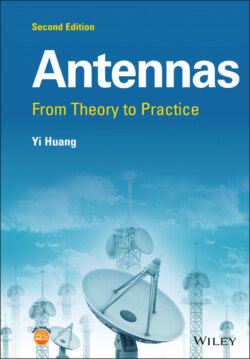Читать книгу Antennas - Yi Huang - Страница 33
Problems
Оглавление1 Q1.1. What wireless communication experiment did H. Hertz conduct in 1887? Use a diagram to illustrate your answer.
2 Q1.2. Use an example to explain what a complex number means in our daily life.
3 Q1.3. Vector and . Findthe amplitude of vector A;the angle between vectors A and B;the dot product of these two vectors;a vector which is orthogonal to A and B.
4 Q1.4. Vector . Find∇ • A;∇ × A;(∇ • ∇)A;∇ ∇ • A
5 Q1.5. Vector . FindThe amplitude of E;Plot the real part of E as a function of t;Plot the real part of E as a function of z;What this vector means.
6 Q1.6. Explain why mobile phone service providers have to pay license fees to us the spectrum. Who is responsible for the spectrum allocation in your country?
7 Q1.7. Cellular mobile communications have become part of our daily life. Explain the major differences between the 2nd, 3rd, and 4th generations of cellular mobile systems in terms of the frequency, data rate, and bandwidth. Further explain why their operational frequencies have increased.
8 Q1.8. Which frequency bands have been used for radar applications? Give an example.
9 Q1.9. Express 1 kW in dB, 10 kV in dBV, 0.5 dB in W, and 40 dBμV/m in V/m and μV/m.
10 Q1.10. Explain the concepts of the electric field and magnetic field, how are they linked to the electric and magnetic flux density functions?
11 Q1.11. What are the material properties of interest to our electromagnetic and antenna engineers?
12 Q1.12. What is the Lorentz force? Name an application of the Lorentz force in our daily life.
13 Q1.13. If a magnetic field on a conducting surface z = 0 is , find the surface current density Js.
14 Q1.14. Use Maxwell’s equations to explain the major differences between the static EM fields and time‐varying EM fields.
15 Q1.15. Express the boundary conditions for the electric and magnetic fields on the surface of a perfect conductor.
